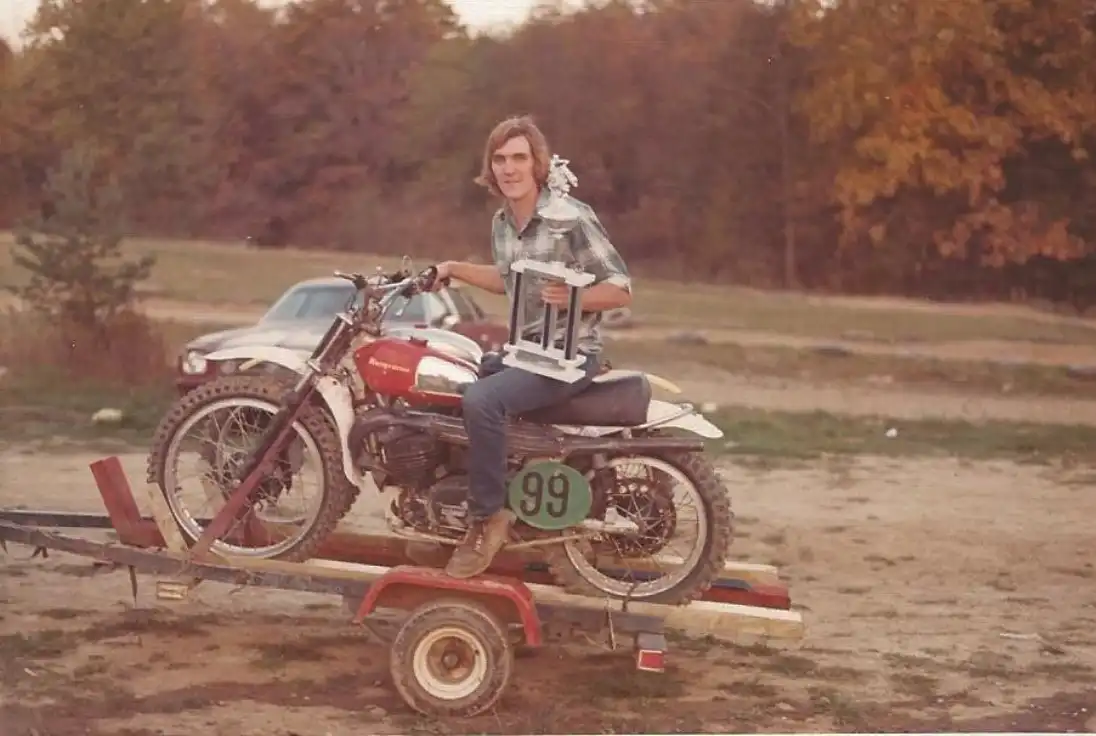Will Stoner
Story and photos by Will Stoner
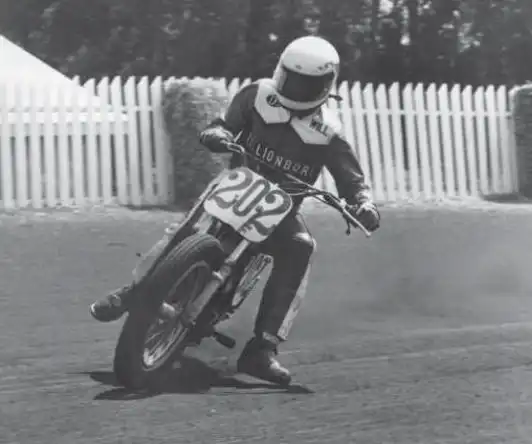
I was born December 26, 1949 in Cleveland. I'm a life-long resident of Chagrin Falls, OH.
My first love was drag racing, but I married motorcycles. I bought a Honda Scrambler 90 in 1967, which I misused and neglected to maintain for three years. Not only did I not change the oil, I didn't know where the dipstick was. In the summer of 1971, a couple friends got Hodakas and started racing motocross. That sounded like fun, so in November I picked up a very used Hodaka Super Rat for a couple hundred bucks. Indian summer was here on the Thursday I brought the bike home. I rode it in my yard long enough to get huge blisters on both hands. By Sunday the weather had turned to snow for my first race. I slathered around in the mud and managed to complete two laps. That was enough to change my life. By the summer of '72, the drag car lay fallow on its trailer and I was racing motorcycles twice a week.
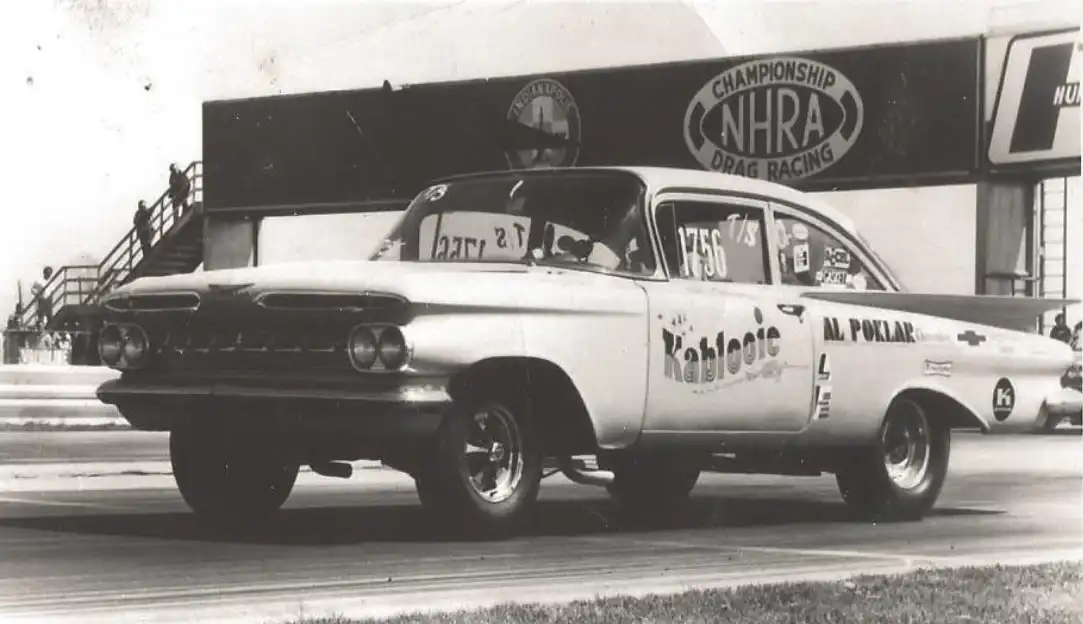
Track and Motocross license and headed to Springfield, Ohio for the traditional season-opener Pro dirt track race. In the early and mid seventies, dirt track still had more riders than motocross and Springfield marked the end of “Cabin Fever Season” for dirt trackers. Springfield drew riders from all over the country. There were thirty or forty Experts, fifty or so Juniors and ONE HUNDRED AND THIRTY Novices. The Novices were divided up into heat races of ten riders each. Only ten riders made it to the Novice Final, so that meant three heat race winners would not make the final.
I was terrified. Novices only got four laps of practice. On my first full-speed lap, I came out of turn two and looked up at turn three. It looked like a solid wall of hay bales. I nailed the brake and hit the compression release. Nine guys flew by me into turn three. I did not finish last in my heat race.
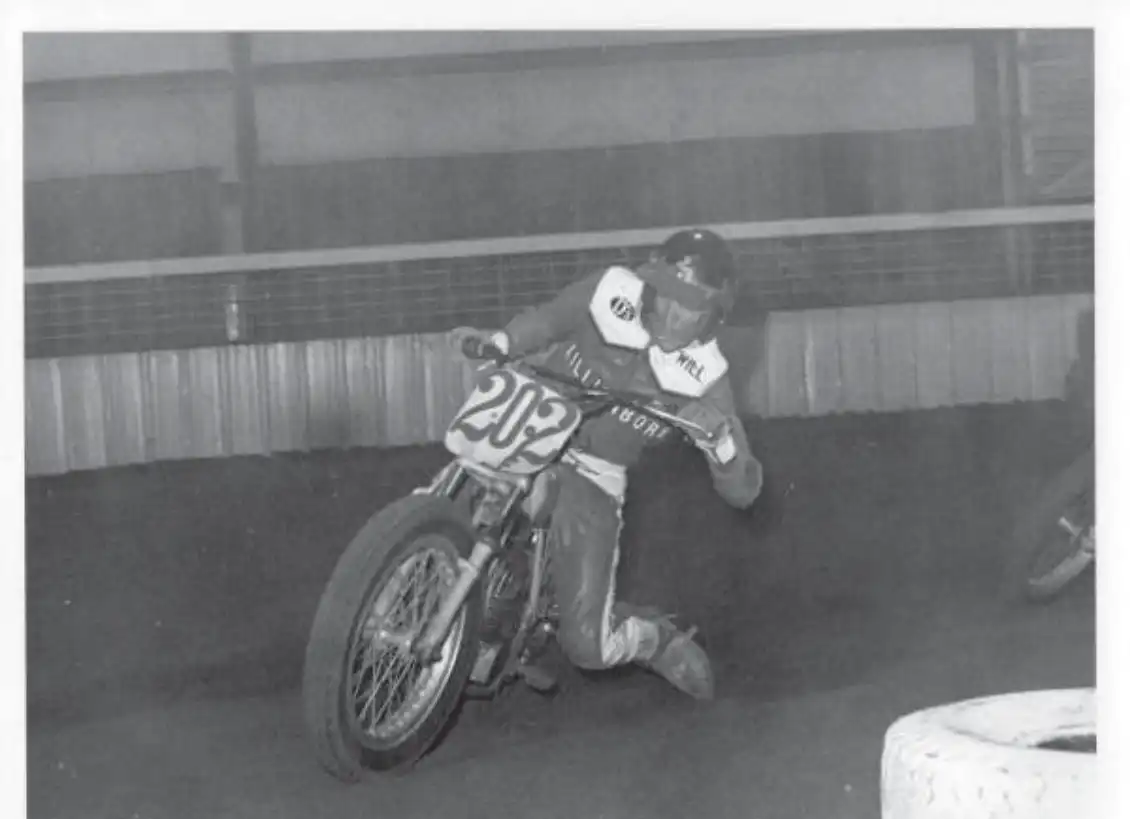
The only forms of motorcycle competition I haven't done are hill climb and enduros. After the Hodaka, I had a brief affair with a ’72 250 CZ. The only good thing that I got from that bike was I met Denny Laidig (a Penton dealer back then and now a KTM dealer). Then came the first in a long line of Husqvarnas, probably fifteen. The Krantz family, George, Peg and racer son Al had a shop in Lakewood, Ohio called Street and Dirt Bike Accessories. Most of my Huskies came from the Krantz’s, but the last few came from Bill and Carolyn Wetzel of Wetzel Suzuki in Mentor, Ohio. I rode Husqvarnas in motocross, hare scrambles and even a few Pro dirt tracks and TTs.
Dirt track racing sunk its teeth into me in 1973. I’d gone to the Charity Newsies in Columbus, Ohio and run local short tracks and scrambles on my MX bikes and most of my bike friends liked flat track. In an argument in a bar in Athens, Ohio my buddy Jeff bet me I couldn’t build him a competitive dirt tracker for his 1974 Novice season. I bought a DT360 Yamaha, Champion frame, wheels, and sprockets and had an engine builder from Michigan breathe on the motor. Jeff won several heat races and came in second in the final at Orville, Ohio in ’74. He came two points short of making his Junior points. Jeff said I won the bet.
Jeff got a full time job in the spring of 1975 and quit racing. After my resounding “success” as a tuner, I figured “How tough can it be to race one of those things?” I got my AMA Pro Dirt Thus began my career as a “Lifetime Novice”. That’s not exactly true, but I’ll get to that later. AMA Pro dirt track racing had a promotion system: Novice, Junior and Expert. All riders had to start as Novices; earn a certain amount of points to become a Junior; then accumulate another set of points to graduate to Expert. Experts were the top of the pyramid. They raced for the Grand National Championship. You needed forty points to move from Novice to Junior. The really fast guys made their points in the first few weeks of the season, even though you couldn’t move up to Junior until the next season. The fast guys made their points in their first year. It took me three. My friend Big Mike dubbed me with the Lifetime Novice title. He also told me one time, “Willie, you’re pretty damn fast out there, but you’re like a rock on the end of a string: You get going faster and faster until the string breaks.” Even though, after three years I did get my Junior points (and Jeff didn’t), I and everyone else consider myself a Lifetime Novice.
Then there were those Pentons. I hated every one of them. When I say “Penton”, I’m not referring to the family. I love them; have since I met them when I worked for the AMA. My racing buddies and I “hated’ anyone who rode a Penton motorcycle in the early Seventies. We hated them because they kicked our asses EVERY WEEKEND! Coincidence made me live smack dab in the middle of all the fastest Penton riders on the planet: Jack, Tom, Jeff, Teddie, Dane, Frank Gallo, the Pieseki’s, Bob Crosier and a host of others. Penton bikes dominated nearly every motocross or hare scramble I entered. Everywhere you’d look, those green (and red and blue and white and orange…) bikes were smoking the competition. If I had really had any animosity toward the Penton family, it would have disappeared when I met them. I’m now honored to consider them friends.
I don’t remember much about racing against the Penton family. I would see them on the starting line, and then I’d see ‘em at the trophy presentation… John Penton, on the other hand, has given me several fond memories off the race course.
By the time I was working for the AMA, I was well aware of JP’S accomplishments, but I had never met or even seen him in person. The only amateur racing class that the AMA requires homologation is the 50cc automatic mini cycle class, the class for the youngest, smallest, least experienced riders. The reason is the Dads cheat like hell.
In January of 1998, Bill Amick, AMA Vice President of Amateur Racing and Special Events, and my boss asked me to go up to KTM Headquarters in Amherst, Ohio to count and inspect the latest batch of KTM “Junior Minis”, their 50cc automatic bikes. It was late on a gray, misty day, not the kind one would like to be outside working. I happened to glance out the window of the warehouse and noticed an older man, in a worn, torn jacket, stocking cap and wrinkled, soiled pants. I thought he might be homeless. Mike Rosso was KTM’s representative with me. I pointed him to the window and asked. “Is that a homeless guy on your property?” Mike said. “Nah, that’s John Penton. He can’t stand to see the place dirty, so he picks up the litter on the property and a half mile along the road in either direction almost every day. That was my first exposure to John’s boundless energy.
The closest to fame I came was winning the 400cc class at the 1979 24 Hours of Nelson Ledges road race in Ohio. But I had three other fast riders and a team of forty people helping. Three months after that race, I suckered one of our crew members, Kit, into marrying me. For the next four years, I dabbled occasionally with bikes until I quit my job and Kit and I started a landscaping company. In an effort to be a "responsible citizen", my stable of motorcycles was sold.
The next two years were spent harassing my lovely bride to let me get another bike. She finally caved in when a friend called the house to ask me if I might be interested his old Yamaha RD250. Several months before, I told the seller, over several beers, to let me know if he ever wanted to sell the bike. I wasn't home and Kit took the call. The selling price was cheap, so she decided to surprise me and have Teddy, the seller, bring the bike to our house that Sunday, knowing that I wouldn't be home until late afternoon. Whatever I was doing turned out to be a bust, so I went home early. You'd think I'd caught her in the bedroom with a boyfriend. She was red-faced and fidgeting. Then Teddy pulled into the driveway with the Yamaha. We walked out to the drive to greet Teddy. I'm so stupid. I said.
"I know Teddy wants to sell this bike. Can I please buy it?”
Smiling, she said "No."
"Why not?"
"It's sold". She said, grinning more. Did I mention I was stupid?
"Who bought it?"
"A woman." She said with a bigger grin.
"Did Grace (a former owner of the Yamaha) buy it?”
"No…." she giggled. The light bulb goes on. I start crying. She starts crying. We start hugging and kissing in the driveway. Teddy thinks we're nuts. Two weeks later I have a trials bike. I'm back in the motorcycle game.
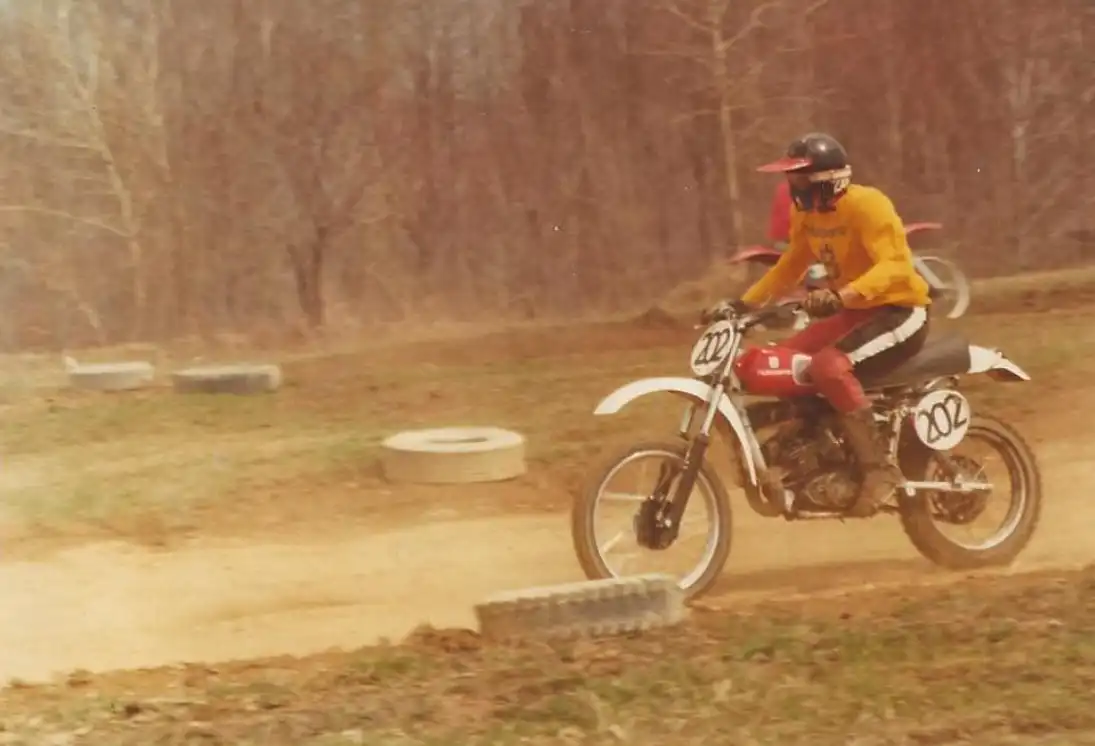
I start riding trials, where I meet Bud Kubena and his then twelve-year-old son, Kerry. Bud is a BSA enthusiast and he and Kerry restore old British bikes. I tell him I'd like to get an old Triumph to restore. He tells me about a 1968 Bonneville rolling basket-case in Pennsylvania. I buy it. The disease sets in. It's incurable.
In the fall of 1989, we're at a friend's party and I'm, of course, talking bikes with another friend, Bruce. We're talking about BSA Gold Stars and Bruce mentions that he has a 1956 BSA B33, the Gold Star's Conservative sibling, which he wanted to sell. I go over to Bruce's house. The bike is really neat. I want it. Bruce is asking $1,100 for it. I don't have $1,100. He says it's mine whenever I want it.
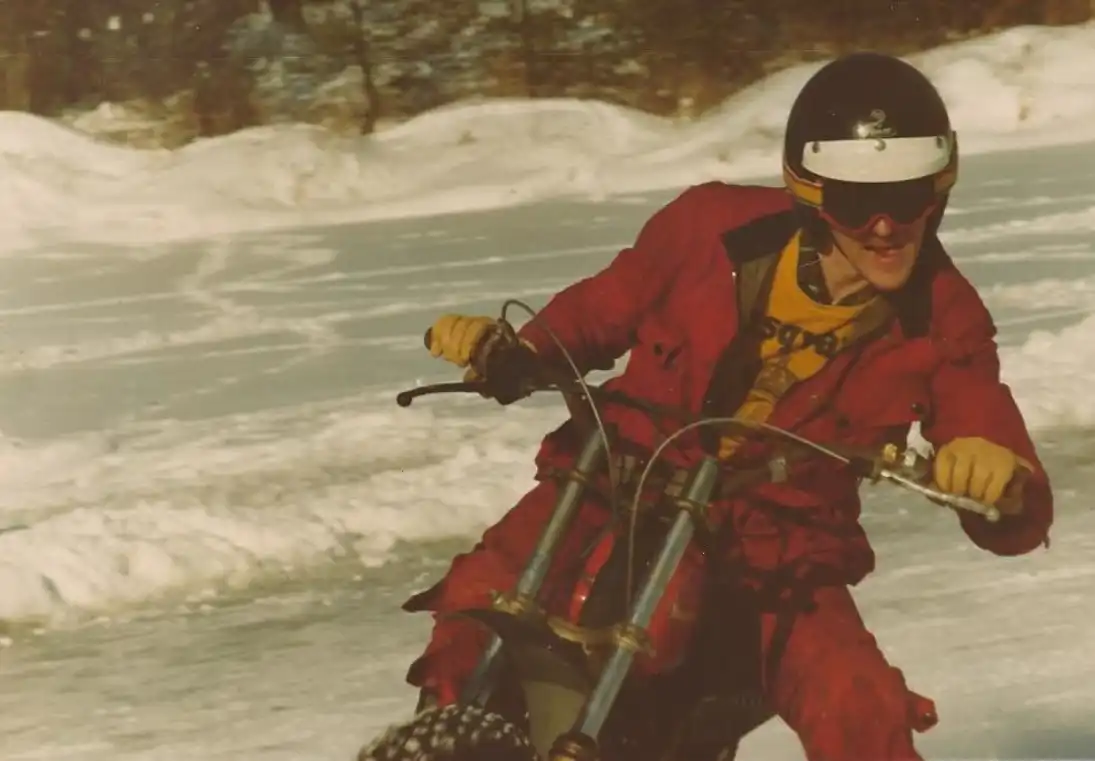
I get a Genius Idea! I'll put on a swap meet. I'm an expert at swap meets. I've been to three. I rent the Chagrin Falls National Guard Armory in Ohio for a Sunday in February, 1990. I scour the phone books, bike mags, and harass friends for addresses. I send out thousands of post cards. I make tons of phone calls. I sell out the Armory: all forty-five spaces! I'm excited. This is great.
It snows eighteen inches Saturday night before the swap meet. I have a landscape business. We have over one hundred plow customers! My seventy five year old mother gets stuck in the snow. I have to go rescue her in the blizzard. I'm having a heart attack!
The snow stops. We get the plowing done. It's 6:00 AM and I drive by the Armory. There are tracks leading in. I figure it's the Sergeant and he's clearing the parking lot. I drive in and there's a guy in a red pickup truck, waiting to get into the meet. I have to plow the parking lot.
Time comes for the show. We pack the place. Everybody has a great time. I make enough money to get the bike. I call Bruce. He says "Ya know, I've decided to keep the bike." I'm now in the swap meet business! Note: Bruce sold the bike to someone else a few years ago. If he weren’t such a good friend, I’d still be ticked at him.
We always invited the American Motorcyclist Association (AMA) to set up a membership table at our swap meets and I became friends with Field Rep Jim Nickerson. I fool him into thinking that I knew what I was doing, so when Mark Mederski, then AMA Vice President, asked Nickerson if he knew anyone who could put on a swap meet, Jim suggested me. Mederski was as easy to buffalo as Nickerson; I produced the swap meet and assisted on other elements of the event at the first AMA Vintage Motorcycle Days (VMD) in July, 1992.The AMA kept me on as an outside contractor to produce the swap meets at VMD through 1997. In 1998, I became full-time employee of the AMA, their Special Events Director. In addition to being responsible for all aspects of VMD, from Grand Marshals to Porta-Johns, I helped produce several AMA International Women & Motorcycling Conferences, Hall of Fame Inductions, as well as producing four AMA Swap Meets each winter. It was my “Dream Job”. I said “I got paid to do what I’d do for free”.
I started planning for the 1991 swap meet in July by reserving National Guard Armory for the middle of February. Unfortunately, I forgot to check with George H. W. Bush. He decided to have a little party in Kuwait. All the Armories in the country were closed to the public in December, 1990. We were out of a site for our event with about two months to find a new site and change all our advertising. In the event promotion biz, two months is like fifteen seconds. The weekend after I got the news that the Armory was unavailable, a couple friends of mine and I decided to drive down to Westerville, Ohio to see the latest exhibit at the AMA’s Motorcycle Hall of Fame Museum. On the way down on Interstate 71, I noticed a building called the “Burbank Auction Barn”. It looked big enough to hold a swap meet. I scribbled down the phone number, called the guy Monday, went down to inspect on Tuesday and signed the contract on the spot.
Burbank is where I met Mark Mederski, starting my journey with the AMA. It’s also where our swap meet business took off. We’d sell out the fifty-some indoor spaces, but more vendors would show up the day of the show. Not wanting to leave money on the table or disappoint my fellow motorcycle enthusiasts, I charged half price for the outdoor spots. We filled the outdoor spots at every event in Burbank, no matter the weather.
After three years at Burbank, the owner announced he was selling the building. We had already outgrown the place, so we started looking for a new venue. I was looking at fairground facilities, found the Richland County Fairgrounds in Mansfield and moved our events there in 1993. The building held nearly a hundred vendors and had a huge, paved parking area. The big parking lot was a good thing, because the outdoor vendors followed us to Mansfield and brought their friends. Several times we had ninety vendors inside and forty or so outside. We continued with two meets a year at Mansfield until 2003 when the AMA, decided to discontinue our winter swap meets. We also produced swap meets in York, Pennsylvania from 1992 until 2002. I picked York because my brother lives there. I saw their beautiful facilities on a trip to his house. York brings back the memory of the strangest happenings ever at one of our events. One of our regular vendors at York was an Englishwoman named Marie, who sold Rocker-style pins and badges. She apparently had some “outlaw biker” pins for sale too. That did not sit well with a bunch of thugs who call themselves the Pagans. Marie had been warned at a previous event not to sell “1%” pins. She also turned out to be the ex-girlfriend of a member of the Hell’s Angels. Angels and Pagans don’t exchange Christmas cards. By this time, the York event had enough vendors to fill two buildings. While I was in the other building, several Pagans had come up to Marie’s booth, knocked over her tables, roughed her up and scattered. Even at a motorcycle swap meet, outlaw bikers, with their unwashed regalia, stick out like tank tops and flip-flops on Prom night. I walked up to the first one I spotted. With my luck, he was about six-foot-six and chiseled from granite. I asked him to take his friends and leave before I called the police. After his expletive filled response, I walked away, pretending not to be terrified. As I was going back to the first building, dialing the police on my cell phone, the big one came up behind me, knocked the phone out of my hand and I skittered down the alley like a scared bunny. A couple weeks later my brother, who had witnessed the festivities, told me that his local TV news reported that the Pagans and Angels had a shoot-out in Allentown. The newscast showed pictures of the deceased combatants. Brother John was sure one of them was the guy who threatened me. Paybacks.
My last event with the AMA was the 2008 Vintage Motorcycle Days. The event set the record for the biggest attendance, most vendor spaces sold and the largest profit for the Motorcycle Hall of Fame. I went on to produce several more events on my own in Ashland and Medina, Ohio, York, Pennsylvania and Elkhart Lake, Wisconsin.
In 2012, I announced that I was retiring from the swap meet business so I could spend more time working on and riding my own bikes. It didn’t take. I’m doing three events a year at the Medina County Fairgrounds for the great folks at Lowbrow Customs. Additionally, I have just come to an agreement with New Jersey Motorsports Park (NJMP) to produce the swap meet and club corral elements of the July 11-13, 2014 NJMP Vintage Motorcycle Festival. Somehow I’ll still squeeze in some riding and wrenchin’.
Next to my wife, Kit and my children, Kit and Scott and Annie, the greatest treasures I possess are the wonderful friends throughout the world I have made from motorcycling.
